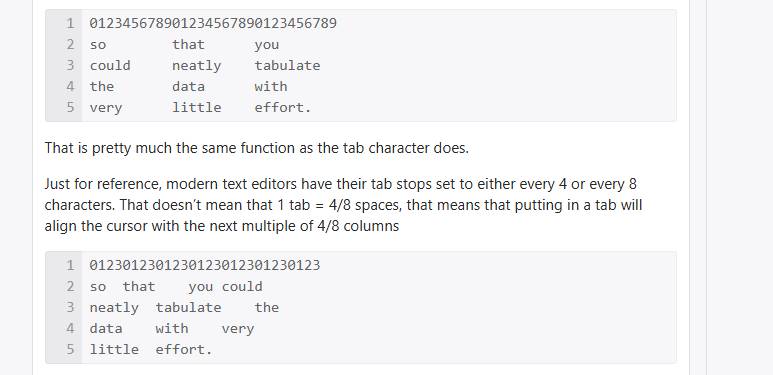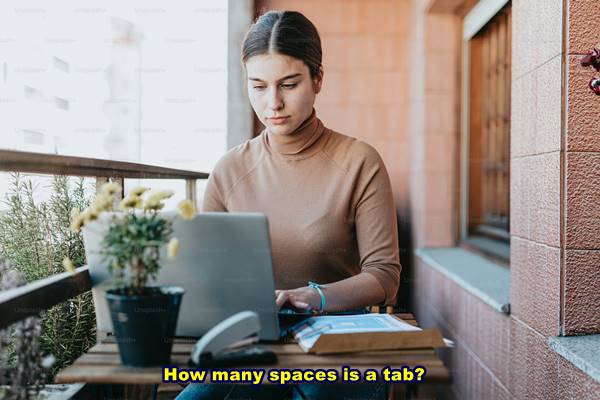How many spaces is a tab?
A tab typically represents a fixed amount of horizontal space. In many text editors and programming environments, a tab is often equivalent to 4 spaces by default, but it can vary depending on the settings or preferences of the software being used. Some configurations might set a tab to 2 spaces or even 8 spaces.
The amount of space represented by a tab character can vary depending on the context and settings of the software or application you are using. In most cases, a tab is considered to be equivalent to 8 spaces. However, it’s important to note that this can be adjusted or customized in certain text editors or word processing software.
Some software programs allow users to modify the tab width or define their own preferences for the spacing represented by a tab. In such cases, the tab size may differ from the default 8 spaces. It’s always a good practice to check the settings or preferences of the specific software you are using to determine the exact spacing value assigned to a tab.
Key Points:
- Default Setting: Commonly 4 spaces.
- Customization: Users can often customize tab width in their settings.
- Best Practice: For consistency, especially in collaborative projects, it’s best to agree on a standard (either tabs or spaces) and stick to it.
How many spaces is a tab?
The number of spaces that is equal to the width of a tab character can vary depending on the software or text editor you are using. In many text editors and coding environments, a tab is equivalent to four spaces by default, but this is not a universal standard. Some software allows users to configure the tab width according to their preferences, and it can be set to different values such as 2, 4, 8, or more spaces.
The choice of how many spaces a tab represents is often a matter of coding style or personal preference. It’s essential to be consistent with the tab width you use in a particular project or codebase, as inconsistent tab widths can lead to formatting issues and readability problems in code and text documents.
Ah, the age-old debate of spaces vs. tabs, a topic that has ignited many a flame war in coding forums and editorials. But when it comes down to the practicalities, the question of “When Typing How Many Spaces Is Equal To The Space Of A Tab?” is actually more straightforward than you might think, yet nuanced in its application.
Traditionally, a tab is considered equivalent to four spaces. This has been the standard in many coding environments and style guides. It’s a nice round number that provides a clear visual separation, making code or text easier to read. However, like with all rules, there are exceptions and variations.
In some circles, especially among developers who work on certain projects or with specific languages, a tab can be equivalent to 2 or 8 spaces. It really boils down to the preferences set by a project’s style guide or the individual’s coding style. For instance, in the world of Python, PEP 8 — Python’s style guide — strongly recommends using 4 spaces per indentation level, underscoring the importance of consistency within the language.
When you’re not coding and simply typing a document, the equivalence of a tab to spaces can depend on the text editor or word processor you’re using. Some programs let you customize the width of a tab, allowing you to define how many spaces it should represent. This can be incredibly handy if you’re particular about the layout of your documents or if you’re adhering to specific formatting guidelines.
Living in Portland, OR, where the coffee shops are filled with novelists, screenwriters, and coders alike, I’ve seen debates over tabs and spaces unfold in real time. Sometimes, it’s over a craft coffee; other times, it’s during a heated Slack exchange. The key takeaway I’ve observed? Consistency is king. Whether you decide on using 2, 4, or 8 spaces, sticking to your chosen style consistently makes your text or code cleaner, more readable, and more professional.
So, while the answer to the question can vary depending on the context, a good rule of thumb for most scenarios is that a tab is equal to four spaces. It’s a standard that balances readability with compactness, although adjustments can and should be made based on the specific requirements of your project or personal preference. Remember, in the grand scheme of things, the goal is clarity and consistency, whether you’re tapping away on your laptop in a Portland cafe or anywhere else in the world.
When typing, how many spaces is equal to the space of a tab?
None.
A tab position is an artificial margin for the alignment of tabulated text. The <tab> character instructs the display processor (or printer engine) to move to the next tab position.
While it was possible on mono-spaced typewriters to space across to the new position (even though mechanical tab stops were usually provided), Proportional Space (and scalable) fonts seriously mess up such hard formatting.
It’s exactly the same scenario as using hard carriage returns when laying up text. It might look
OK at the time of typing, but if the margins, font, or font size are altered it throws everything
into chaos.
If you are using a proper word processor, the Tab key will move to the next tab and you then commence typing the next section. By default, MSWord sets automatic tab-stops every 1/2″ and, when editing someone else’s document, it is not uncommon for me to encounter attempts at multiple spaces to get tabular alignment, or even multiple tab markers indicating that the original author had never been taught how to use tabs correctly.
Of course, it is still possible to enlarge a font so that the previous text now pushes into the newly tabbed position. This problem has been addressed by the ability to insert proper tables, so that all text is contained within one cell. If DOSWord 5.5 had a proper table feature, I would never have migrated to Windows. The work around with side-by-side paragraphs was just too messy (and memory crashing) for the complexity of documents on which I work. For me, this is a comparatively simple example:
Try getting all those vertical alignments correct with just the spacebar! Note that there are also dotted underline bars in the Vendor and Purchaser columns, but they don’t show up at the resolution of my screen capture.
If you are using something like Notepad, the Tab key will automatically insert four spaces. It doesn’t care about the character position in the current line of text, four spaces has been hard-coded into that editor. After all, it’s for creating quick notes (usually to oneself), not laying out fancy documents.
In an electronic world, spaces and tabs are two very different beasts, just as different as line breaks and paragraph markers, and understanding these things properly is what separates a typist from a typographer. Unfortunately, most courses in Word Processors don’t teach these important details. Those of us who started on mechanical typewriters and progressed up the technological ladder through the evolutionary years were able to figure them out for ourselves.
Is Fox now free with Amazon Prime?
How many spaces is a tab in Java?
A tab is not made out of spaces. It is a tab, whether in Java, Python, Rust, or generic text file editing. It is represented by a single Unicode character, U+0009.
It does not generally mean “insert this many spaces here” either. It means “put the cursor at the next closest tab stop in the line”. What that means exactly depends on the context. On an old typewriter I had, a tab key would advance the roller to the next column that was a multiple of 10

Why do some people type with two spaces?
Putting two spaces after a period originated with typewriters and manual type-setting. It looked nicer and was easier to read. It made it easier to tell that a sentence was over and it wasn’t just another space between two words. The typefaces we now use are mostly on computer screens, and the space given to a period is clearer, making the end of a sentence easier to differentiate from the space between words. So two spaces after a sentence are no longer necessary. In print, some typefaces still look better with two spaces after a sentence. It’s up to the discretion of the designer at that point.
The practice of using two spaces after a period stems from traditional typing conventions, particularly from the era of typewriters. Here are some reasons why some people still use this method:
1. Typewriter Influence:
- Monospaced Fonts: On typewriters, each character takes up the same amount of space, making it visually clearer to add two spaces after a sentence for separation. This helped to delineate the end of one sentence and the beginning of another.
2. Readability:
- Some people believe that using two spaces improves readability, providing a clearer visual break between sentences, especially in longer texts.
3. Habit:
- Many people learned to type on typewriters or were taught to use two spaces in school, so it has become a habit that persists into digital typing.
4. Personal Preference:
- Personal comfort and preference play a role. Some individuals simply prefer the way it looks or feels when typing.
Modern Standards:
- In modern writing and digital typesetting, the standard is typically to use a single space after a period, especially in professional and academic settings. This aligns with guidelines from style manuals such as the Chicago Manual of Style and the APA Publication Manual.
While using two spaces is less common today, particularly with the prevalence of proportional fonts that automatically adjust spacing, some people continue to use this method out of tradition or personal preference. Ultimately, consistency in whatever style you choose is key!
Conclusion
The number of spaces a tab represents depends on the editor or IDE, but it’s usually 4 or 8 spaces. The tab length is configurable, so you can set it to a different number of spaces. For example, in CSS, the default tab size is 8 spaces, but it can be any positive integer.
Tabs are useful because they can be customized and are descriptive. They tell the editor how much indentation to add, and users can choose to use tabs for indentation and spaces for alignment. Files formatted with tabs are usually smaller because a single tab character represents multiple whitespaces.
The number of spaces that equals the width of a tab can vary depending on the settings of the text editor or word processor you are using. However, a common convention is:
- 1 tab = 4 spaces (often used in programming and many text editors)
- 1 tab = 2 spaces (sometimes used in coding styles, especially in Python)
You can usually adjust the tab width in your editor’s settings to match your preference.
The quantity of spaces equivalent to a tab character’s width can fluctuate based on the software or text editor employed. While many text editors and coding environments default to a tab being equivalent to four spaces, this is not a standardized rule across all platforms. Various software options permit users to personalize the tab width to suit their preferences, with options including 2, 4, 8, or more spaces.
The decision of how many spaces a tab should signify often boils down to coding style or individual choice. Maintaining consistency with the chosen tab width within a specific project or codebase is crucial. Inconsistencies in tab widths may result in formatting challenges and hinder code and text document readability.
How many spaces is a tab?
